To elevate your vegetable cutting skills, start by mastering the chef's knife grip and stabilizing your cutting board. Perfect the rocking motion for efficient chopping, and learn to dice onions tear-free. Create uniform vegetable pieces for even cooking, and practice julienning for precise, matchstick-like cuts. Don't forget to slice delicate herbs efficiently to preserve their flavors. These techniques will speed up your meal prep, improve dish presentation, and enhance overall cooking safety. With practice, you'll develop muscle memory and confidence in handling various vegetables. By incorporating these tips, you'll soon be slicing and dicing like a pro in your home kitchen.
Core Insight
- Master the chef's knife grip by holding the handle comfortably and placing your thumb and index finger on the blade sides.
- Stabilize your cutting board with a damp towel or rubber mat to prevent slipping during use.
- Perfect the rocking motion technique for smooth, efficient cutting of vegetables.
- Use strategies like freezing onions or wearing goggles to minimize tears when dicing onions.
- Create uniform vegetable pieces by slicing into planks, then strips, and finally cubes with a perpendicular knife.
Master the Chef's Knife Grip
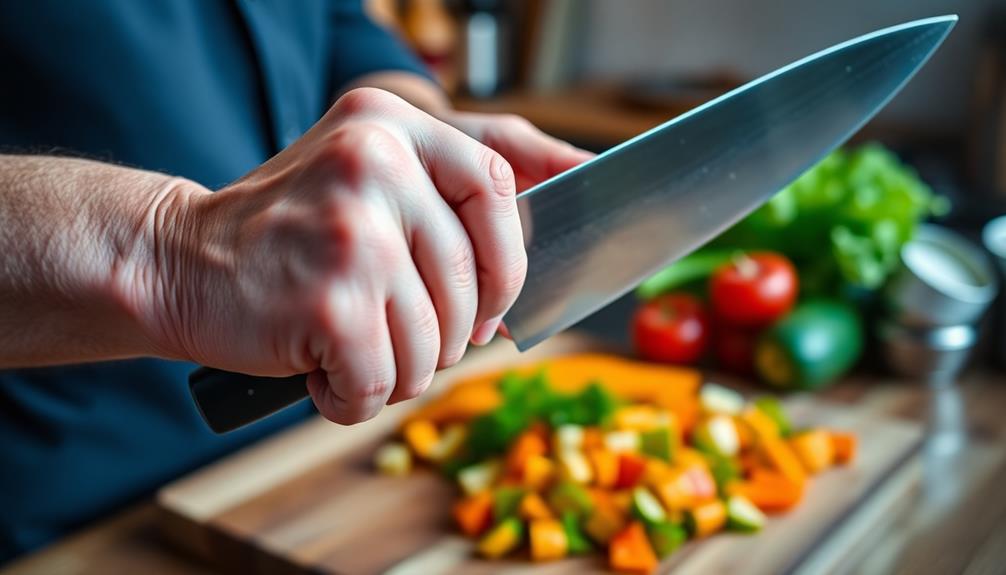
To master the chef's knife grip, hold the knife handle with your main hand. Wrap your fingers around it for comfort. Put your thumb and index finger on each side of the blade, just above the handle. This grip keeps the knife stable and controlled.
Make a "claw" with your other hand. Tuck your fingertips under to keep them safe. Use this hand to hold the vegetable on the cutting board. Let the knife blade rest against the knuckles of your other hand as you cut. Your knuckles can guide the knife.
Practice this grip with different vegetables. Focus on keeping a steady, rocking motion with the knife. Keep your wrist straight. Use the weight of your arm to power the cuts, not just your hand.
Stabilize Your Cutting Board
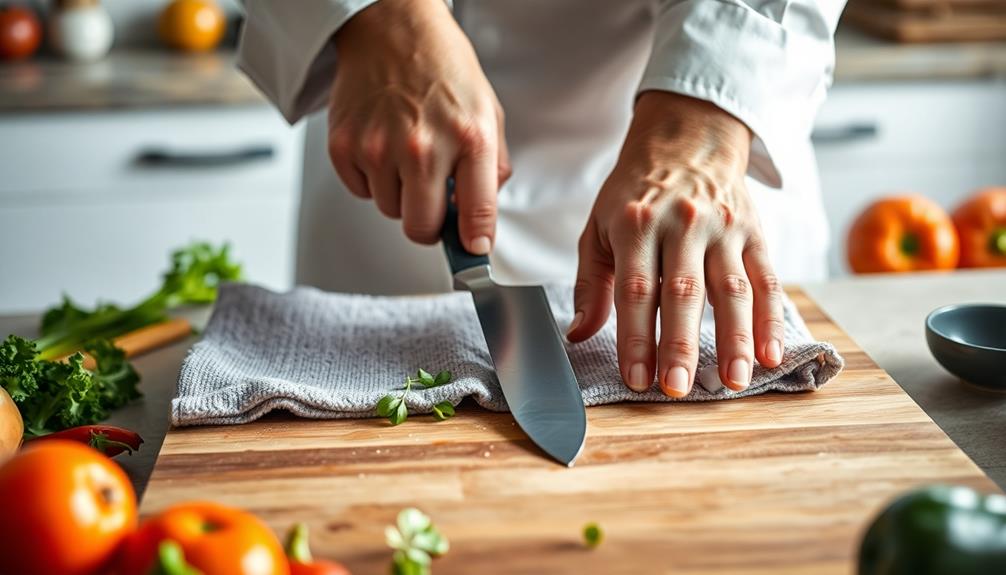
Keeping your cutting board stable is just as important as holding your knife correctly. A steady cutting surface keeps you safe and helps you work better in the kitchen. Use these tips to stop your board from moving around:
- Put a damp towel under your cutting board for grip.
- Buy a rubber mat made to keep cutting boards in place.
- Use the grooved area on your counter if you have one.
- Make sure your countertop is clean and dry first.
- Think about getting a heavy wood or stone board that won't slip.
Perfect the Rocking Motion
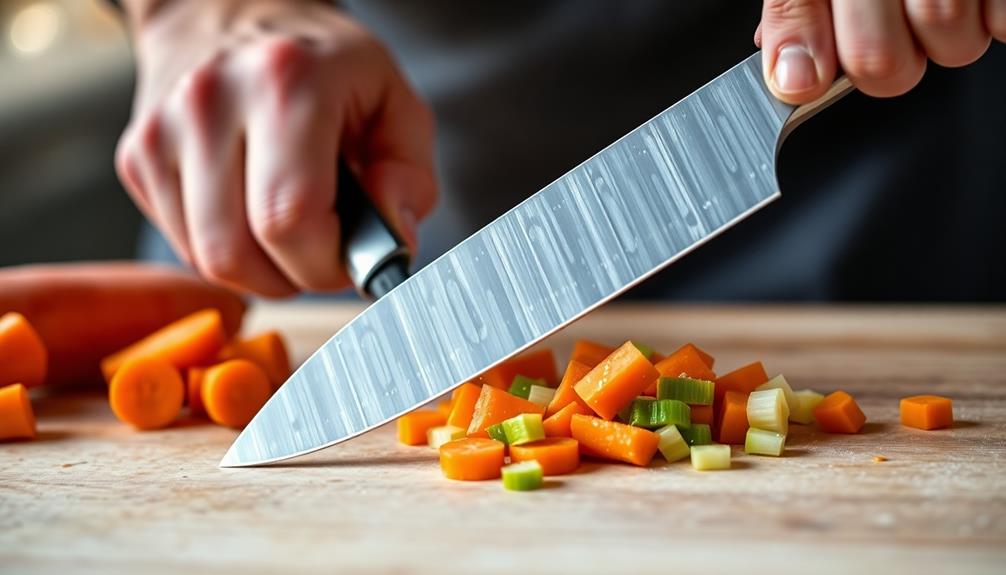
Mastering the rocking motion is essential for chopping vegetables efficiently. To perfect this technique, place the knife's tip on the cutting board with the handle slightly raised. Keep the tip on the board as you cut, using a smooth, rocking motion to guide the blade through the vegetable. This helps you maintain control and make quick, accurate cuts. For better stability and precision, use a cutting board to support your wrist and forearm while practicing.
Start slowly, keeping your fingers safely away from the blade. As you get more comfortable, gradually speed up. Use the entire knife for larger vegetables, and adjust your grip for different sizes and textures. With regular practice, the rocking motion will become second nature, improving your chopping speed and accuracy.
Dice Onions Tear-Free

Tired of crying while cutting onions? Try these simple tips to keep your eyes dry:
- Put the onion in the freezer for 10-15 minutes before you start chopping.
- Always use a sharp knife. Dull blades crush the onion and release more irritants.
- Chop near running water or a fan to help disperse the fumes.
- Don't cut off the root end – it has the most compounds that make you tear up.
- Wear goggles to create a barrier between your eyes and the onion vapors.
- Work quickly and efficiently to minimize your exposure to the fumes.
- Breathe through your mouth to reduce the amount of irritants reaching your nose and eyes.
Follow these steps and you'll be able to dice onions without shedding a tear!
Create Uniform Vegetable Pieces
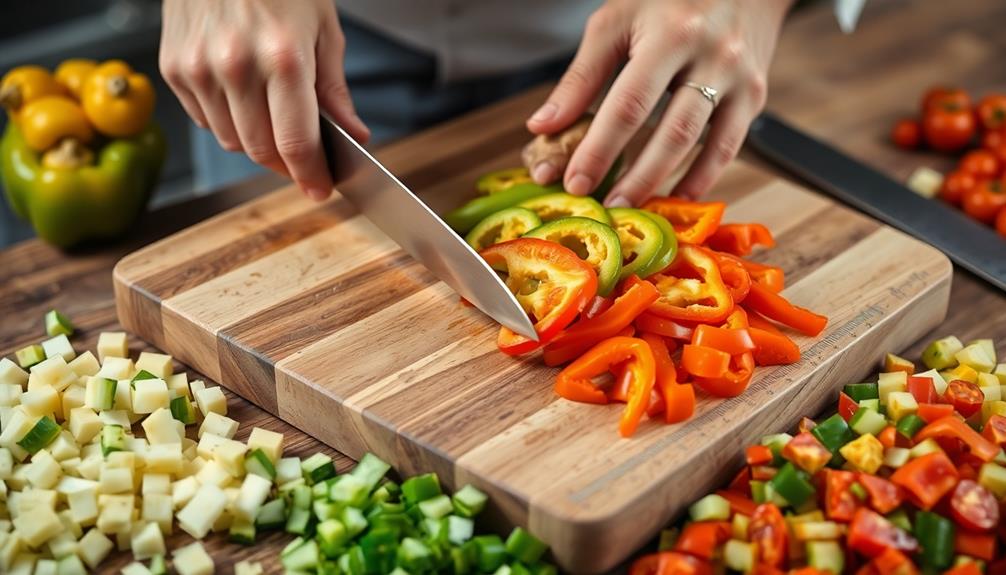
Mastering uniform vegetable cuts is key to even cooking and a polished dish. Pick the right knife, usually a chef's knife, and create a flat surface by halving the vegetable. Place it cut-side down for stability. For long veggies, slice lengthwise into planks, then strips, and finally cubes. Quarter round vegetables first, then slice or dice. Keep your knife perpendicular to the board for clean cuts. Regular practice will develop muscle memory, making uniform cuts effortless.
Julienne With Precision
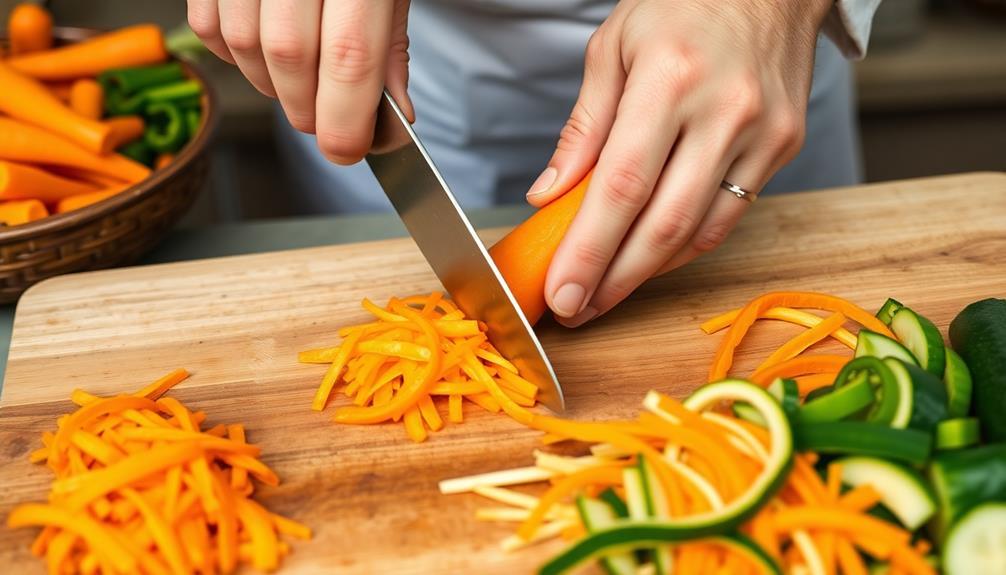
To julienne vegetables perfectly, start with slices that are all the same thickness, about 1/8 inch. Make a neat stack of these slices and cut them into thin 1/8-inch strips. The strips should be 2-3 inches long, like matchsticks. Choose fresh, high-quality vegetables for the best look and flavor.
Use a sharp knife and curl your fingers under while cutting to stay safe. Rock the knife smoothly for clean cuts. If julienning is new to you, begin with hard vegetables like carrots before trying softer ones.
Slice Delicate Herbs Efficiently

Slicing delicate herbs is easy with the right technique. First, stack the herb leaves and roll them tightly. Then, use a sharp knife to cut thin slices across the roll, making ribbons. This is called chiffonade and works well for basil, mint, and sage.
For small herbs like parsley or cilantro, gather them and use a rocking motion to chop finely. Keep your fingers curled under to stay safe.
Quick guide to slicing herbs:
| Herb | Technique | Best Uses |
|---|---|---|
| Basil | Chiffonade | Garnish, Salads |
| Parsley | Fine chop | Sauces, Soups |
| Rosemary | Strip leaves | Roasts, Stews |
| Chives | Thin slices | Garnish, Dips |
Frequently Asked Questions
How Do I Sharpen My Kitchen Knives Properly?
To sharpen your kitchen knives properly, you'll need a whetstone or honing rod. Hold the blade at a 20-degree angle and slide it across the stone or rod, alternating sides. Repeat this process until you've achieved a sharp edge.
What's the Best Cutting Board Material for Preserving Knife Edges?
You'll want to choose a wood or bamboo cutting board to preserve your knife edges. They're gentler on blades compared to harder materials. Avoid glass or stone boards, as they'll quickly dull your knives. Plastic's okay but less durable.
How Often Should I Replace My Kitchen Knives?
You should replace your kitchen knives when they're no longer effective, even after sharpening. This typically occurs every 5-10 years, depending on usage and care. However, high-quality knives can last much longer with proper maintenance.
Are Ceramic Knives Better Than Steel for Cutting Vegetables?
While ceramic knives are incredibly sharp and great for veggies, they're not necessarily better than steel. You'll find pros and cons to both. Ceramic's lightweight and doesn't rust, but it's brittle. Steel's more versatile and durable.
What Safety Precautions Should I Take When Handling Sharp Knives?
Always keep your fingers away from the blade. You'll want to grip the knife firmly, use a cutting board, and never try to catch a falling knife. Don't leave knives in sinks or drawers without guards.

